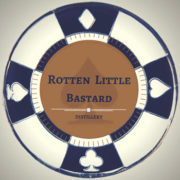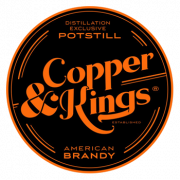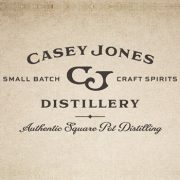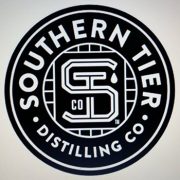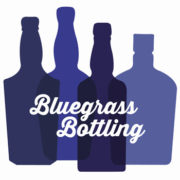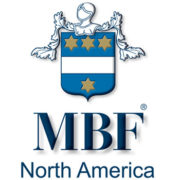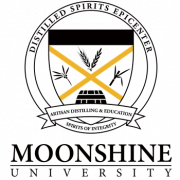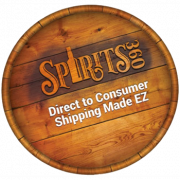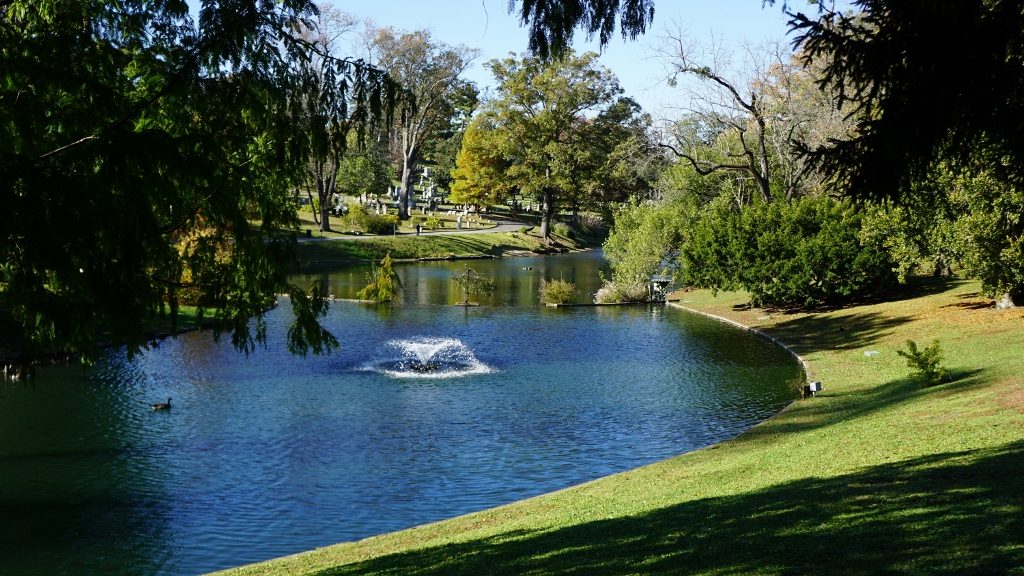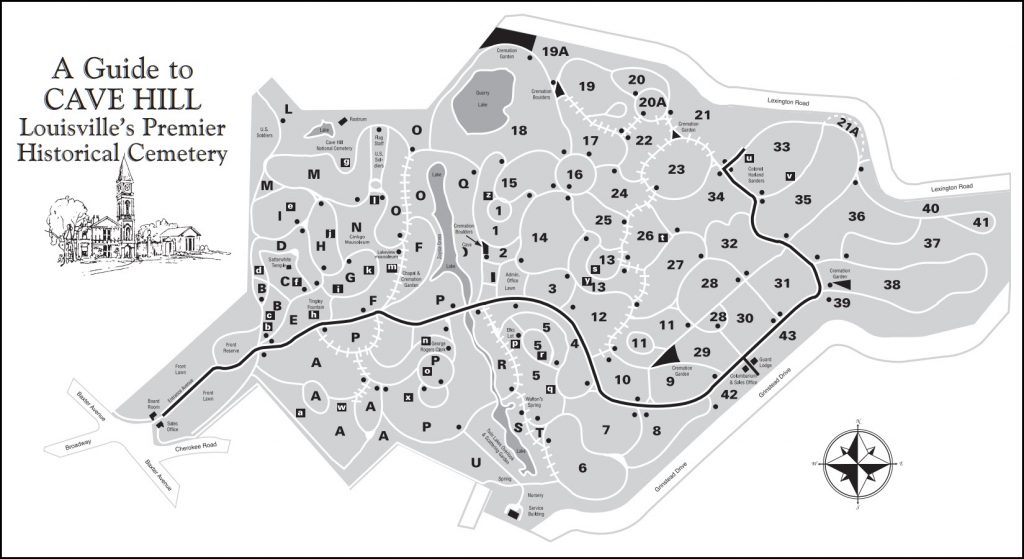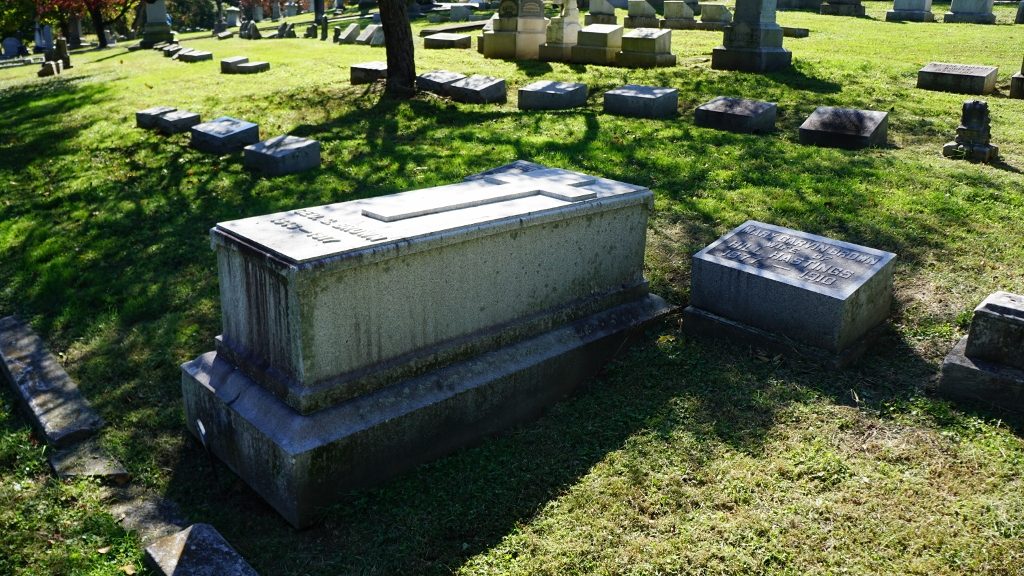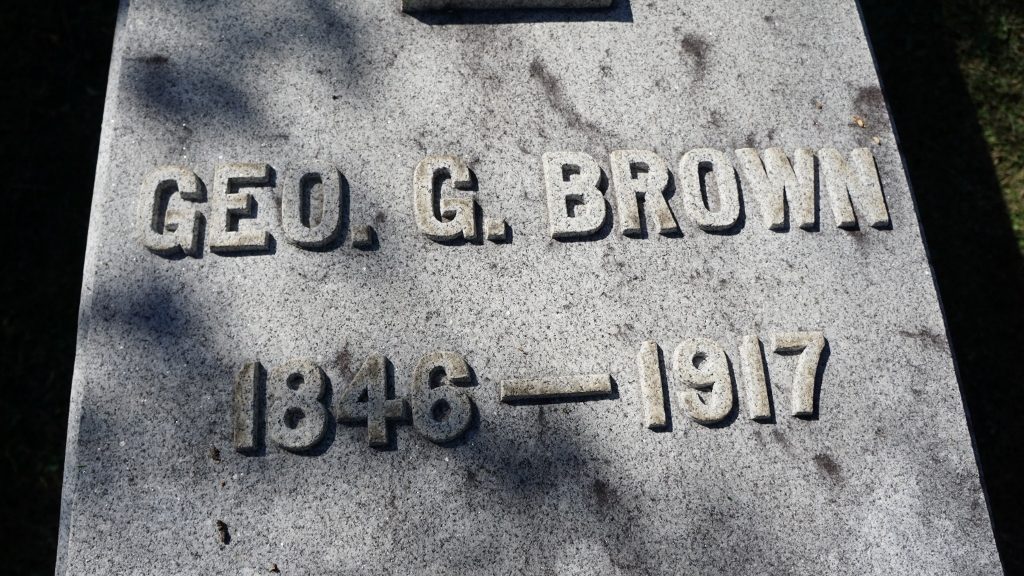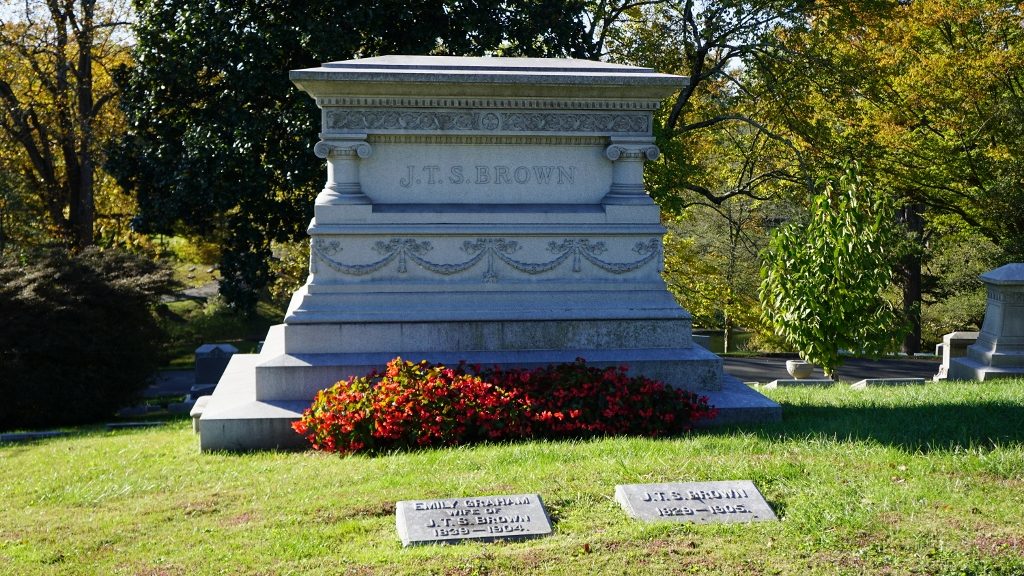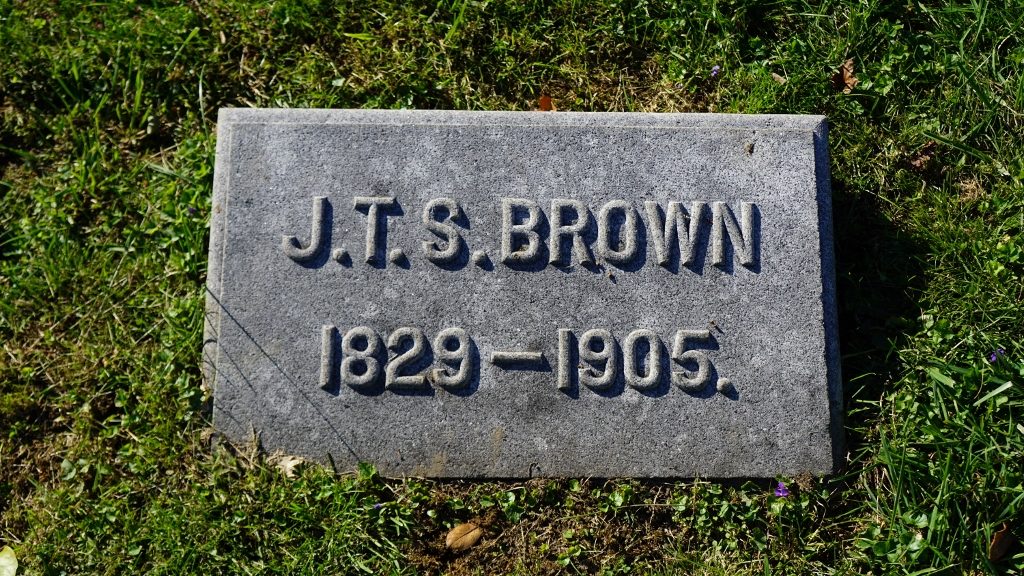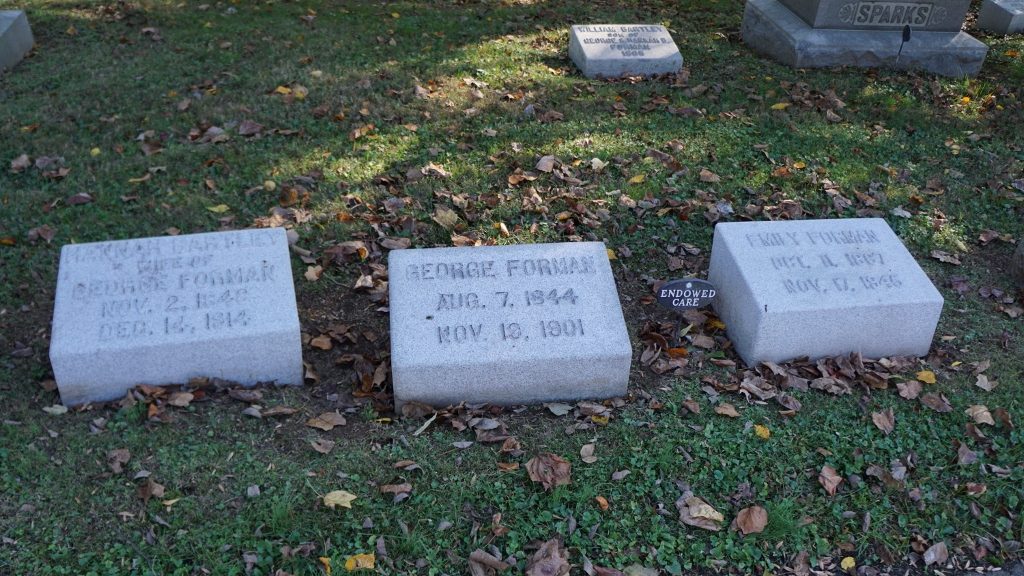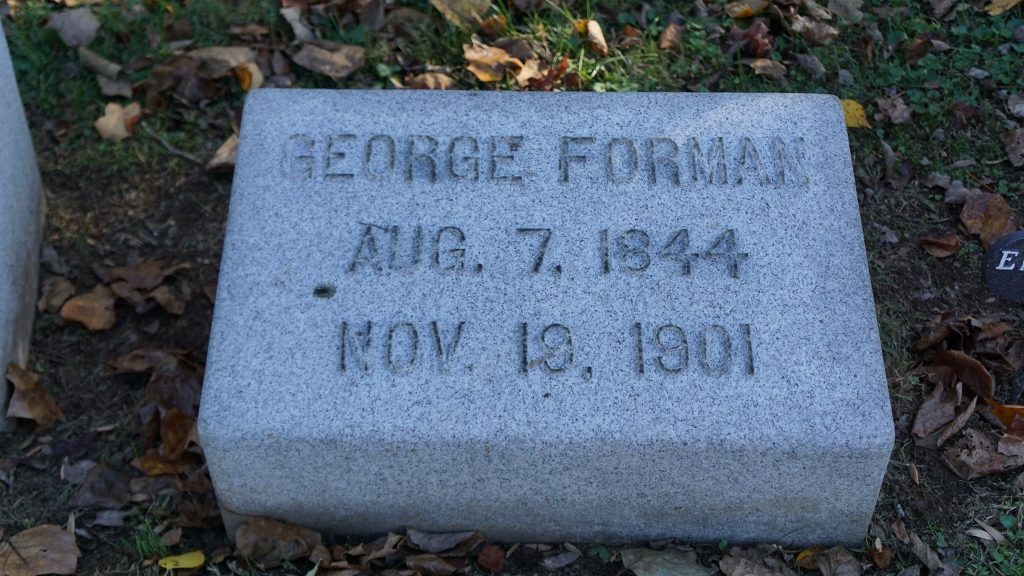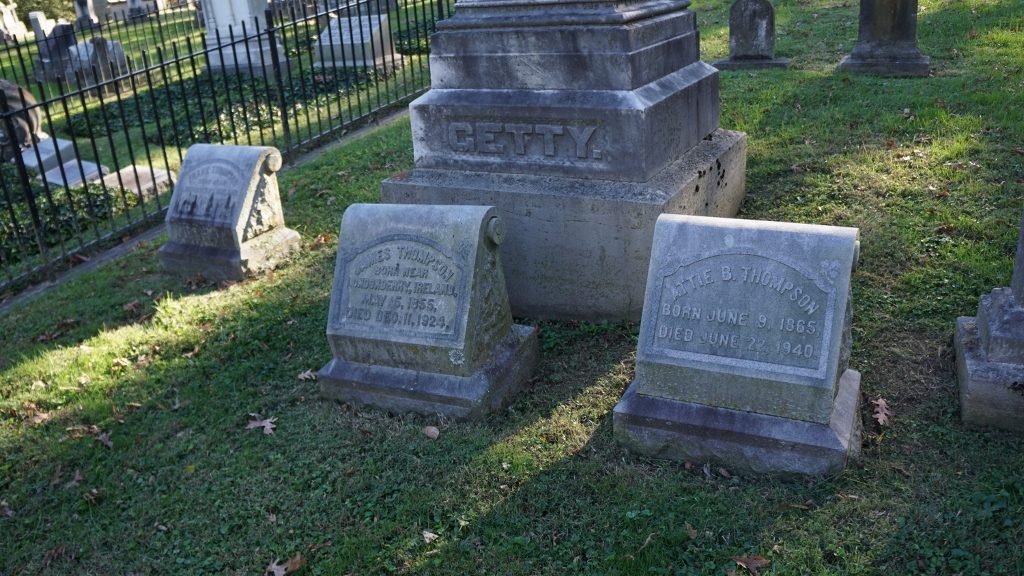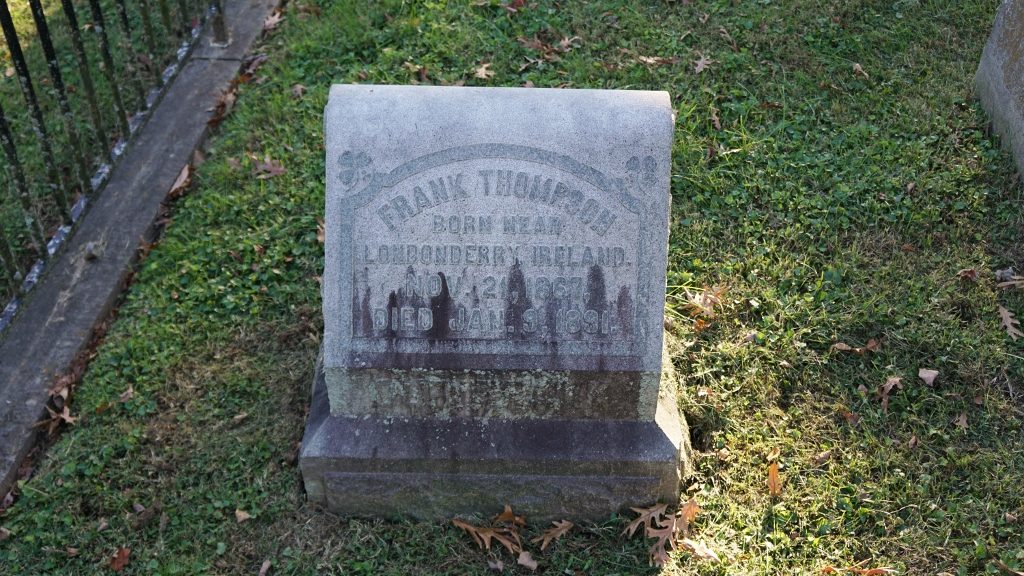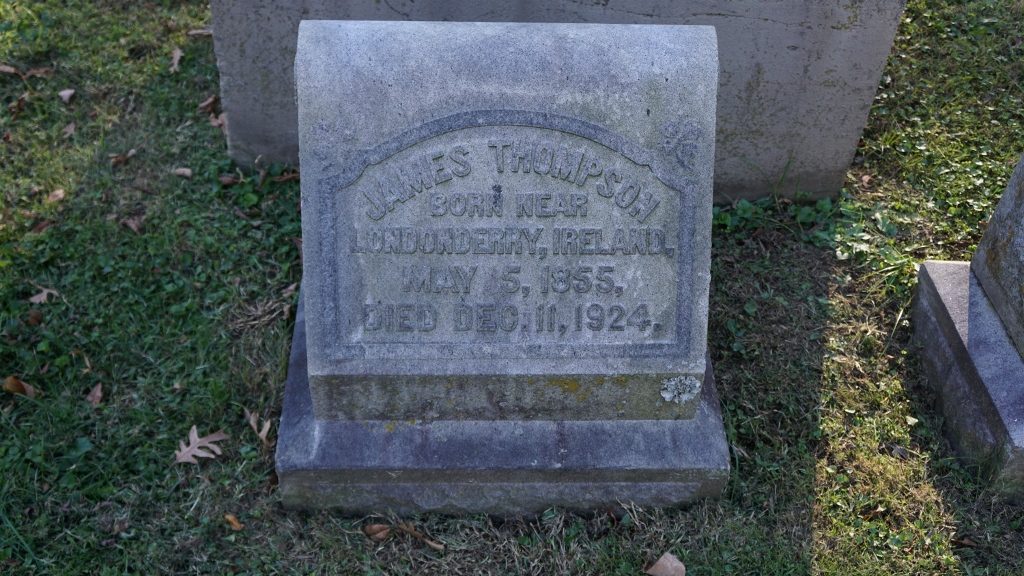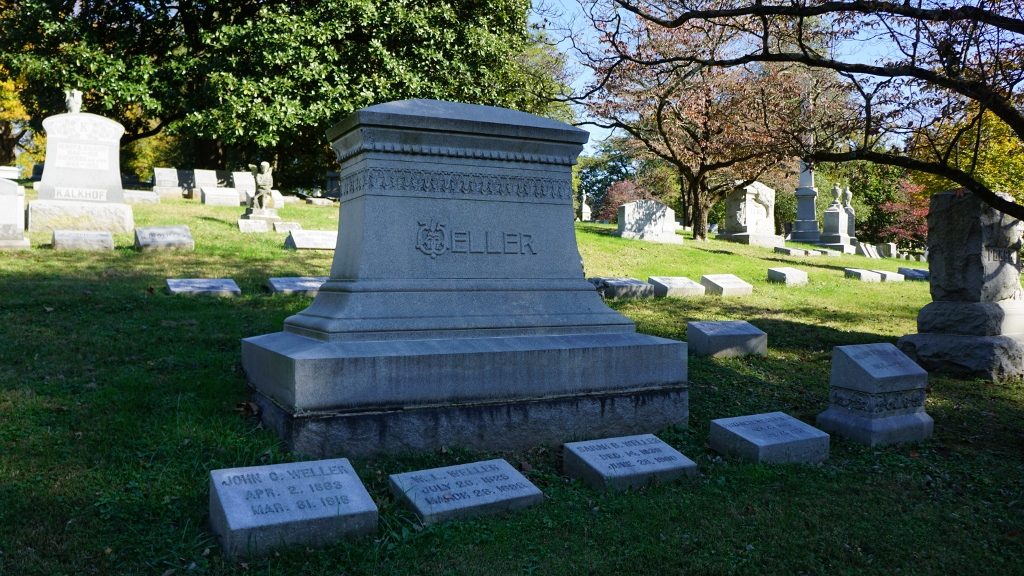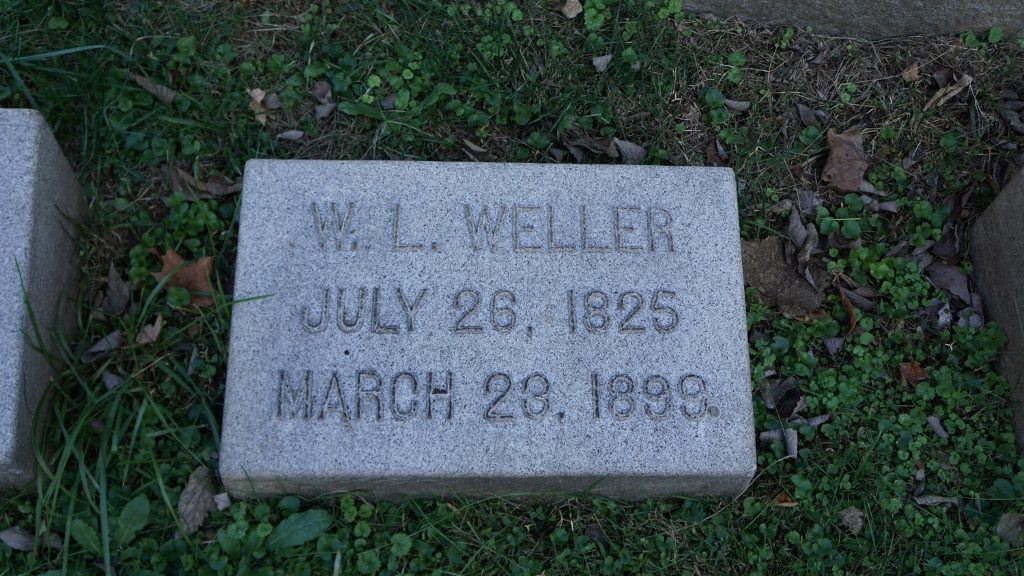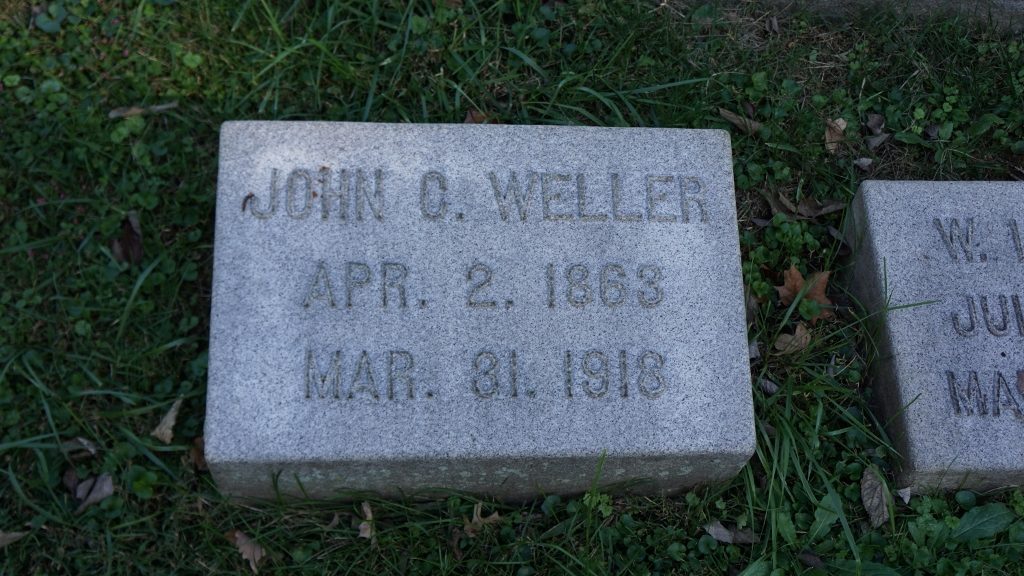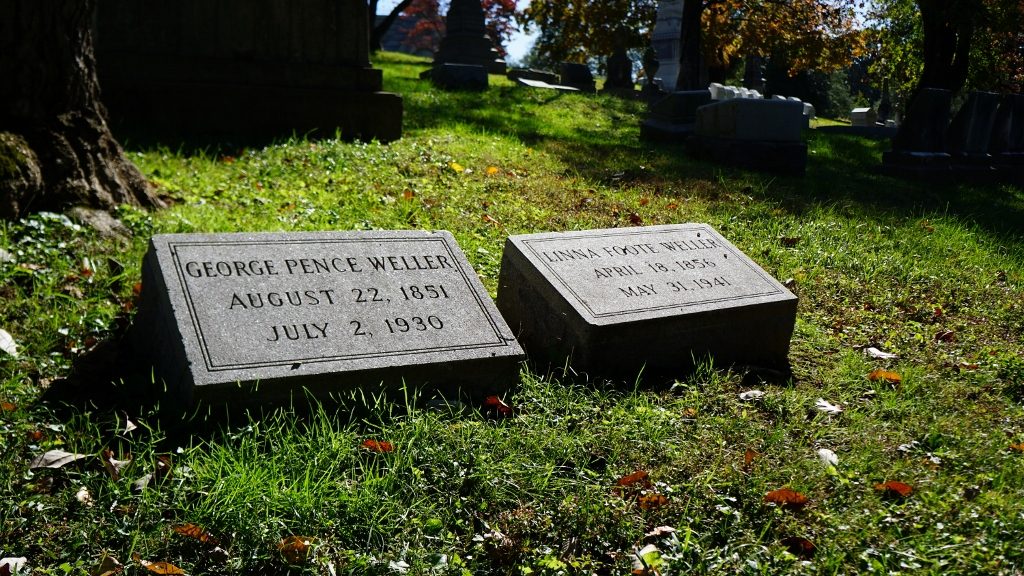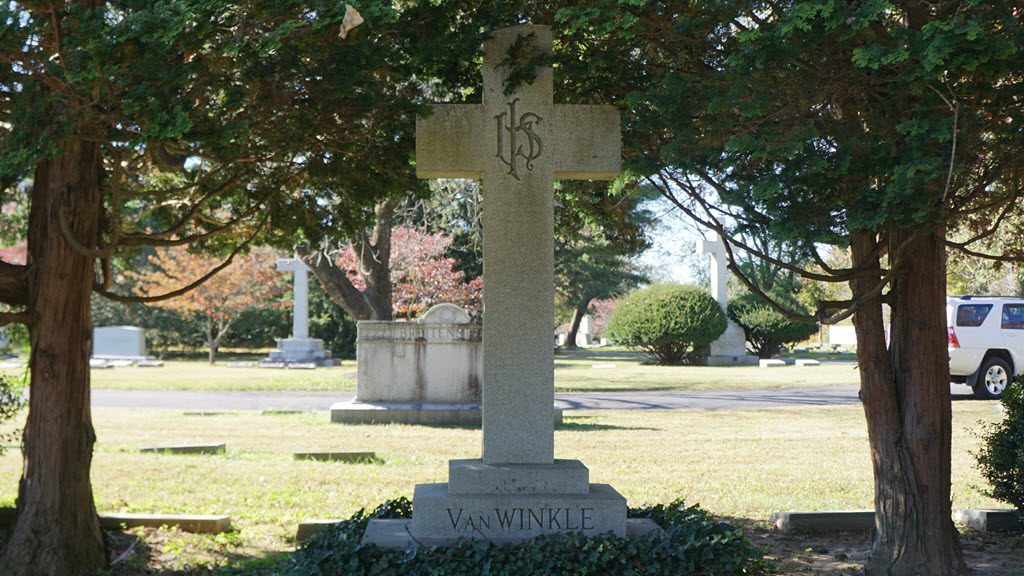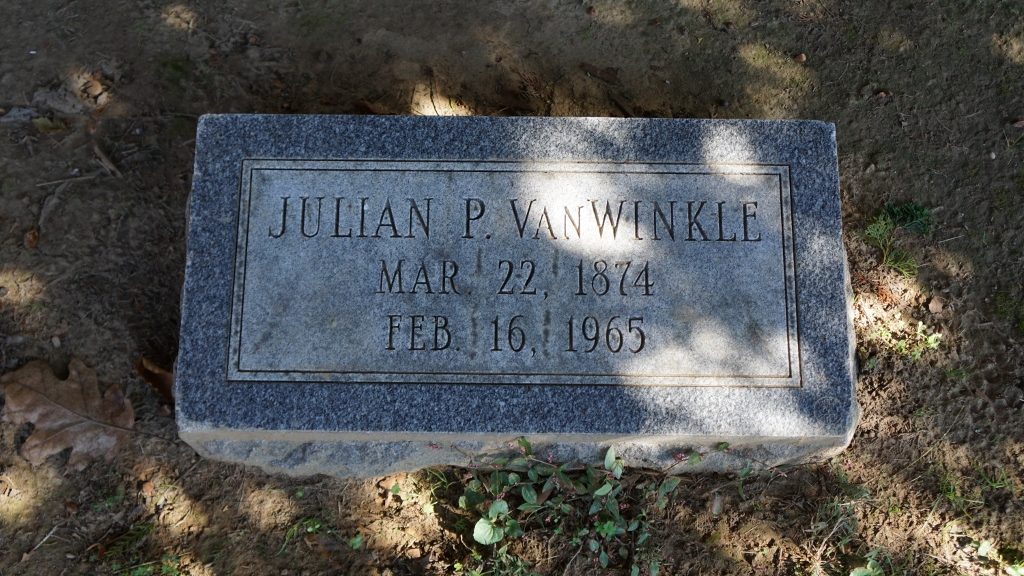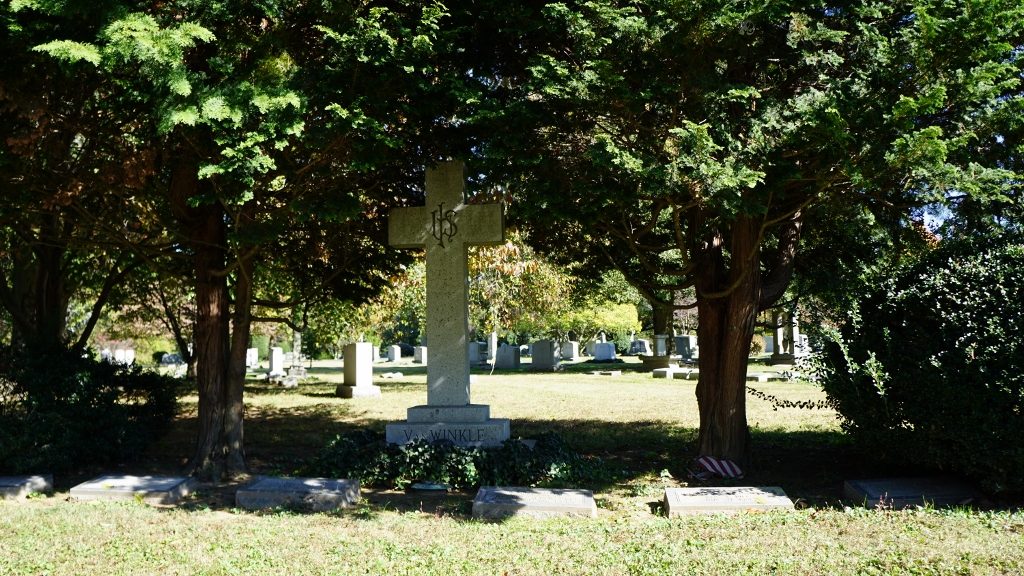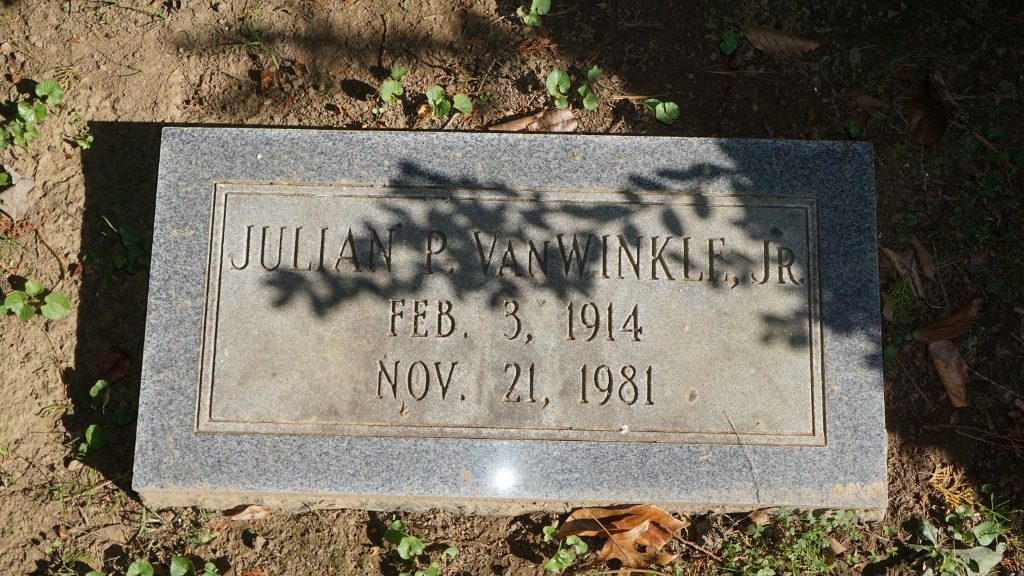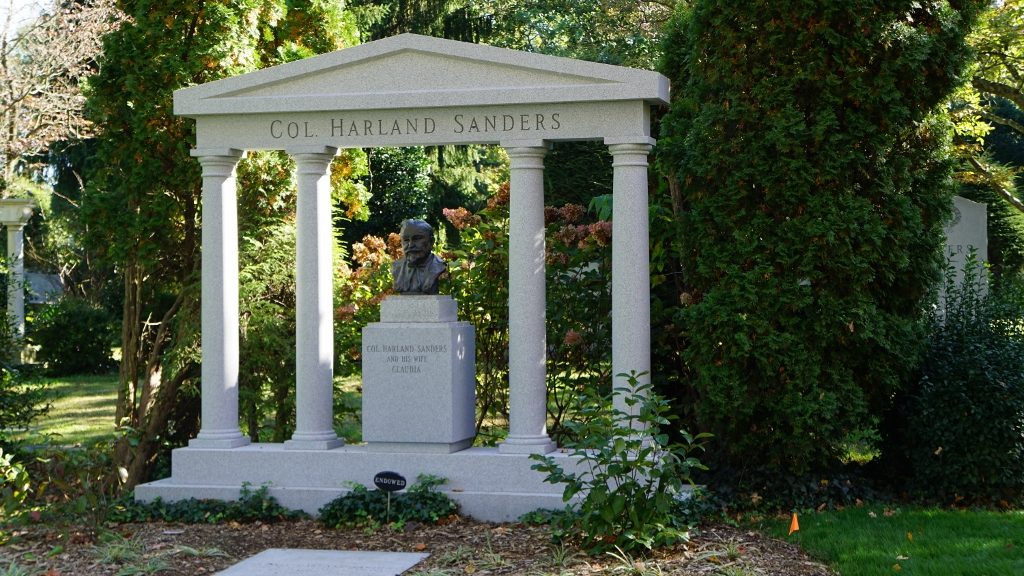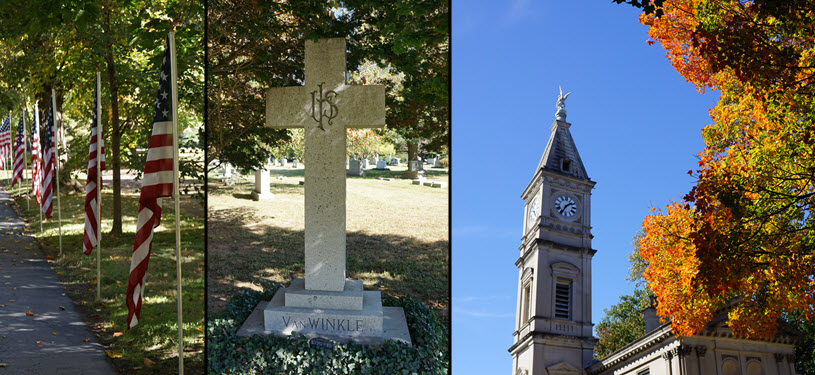
This latest Tale from the Trail is an excursion to the “City of the Dead,” the final resting place for many distillers, rectifiers, and resellers. We are exploring a number of people that have influenced the distilled spirits world that are buried at Cave Hill Cemetery.
Let’s start out by setting the record straight, it is “cemetery” but as soon as you enter through the wrought iron gates you’ll quickly discover this place is really a living museum dedicated to the people that once traveled the earth. It’s better defined as an outdoor museum with hundreds of exquisite works of monumental art made up of granite, marble, wrought iron and bronze marking the gravesites of local citizenry.
The History of Cave Hill Cemetery
In 1848 what was once Cave Hill Farm on the outskirts of town was turned into a small, beautiful cemetery, Cave Hill Cemetery. The farms irregular landscape was ideally suited for the formation of a rural cemetery. Over a period of 30 years, the cemetery acquired tracts of adjoining land that now total 296 acres, a parcel of land that would be considered a small town if the 196,000 inhabitants were among the living.
This town known in the mid 1800’s as the “City of the Dead”, is made up of 16 miles of paved roads, five lakes, 600 species of plants and trees and one quarry. Cave Hill was named for the cave on the east bank of the main lake that runs 246′ into the hillside. Quite appropriately for the distillers interned on the grounds the caverns are limestone, made up of chain-coral and upper magnesian cliff limestone and of course, a good spring.
How to Get Around Cave Hill Cemetery
Believe me, when visiting Cave Hill Cemetery, it’s easy to get lost, partly because you are so busy looking at the beautiful surroundings and partly because of its nearly 300 acres and miles and miles of twisting and turning roadways. The main road features a solid white line down the middle. If you follow the white line, you will eventually arrive at one of the two main entrances/exits. (I wish I understood this before my visit.) Roads with the broken white lines intersect the solid lines which will eventually lead you to an exit. A solid yellow line (think chicken and 11 herbs & spices) marks the road from the Grinstead Road entrance to Col. Harland Sanders’ final resting place.
There are two levels of maps, there’s the large map of the entire 296 acres. It’s a great reference but, don’t be fooled, you’ll need to look at each individual map to find what you are looking for. If you are up for an adventure, you need to visit the cemetery in person to go on this scavenger hunt into distilling history. If you’re not up for a road trip, no problem, pour a good glass of your favorite distilled spirit and enjoy this two part story.
Related Story
Part 2: A Day on the Trail: A Tour of Dead Distillers at Cave Hill Cemetery
Cave Hill Cemetery Map
Stay Informed: Sign up here for the Distillery Trail free email newsletter and be the first to get all the latest news, trends, job listings and events in your inbox
Historic Distilled Spirits People at Cave Hill Cemetery
We put together a brief bio on each person, a photo of their marker be it a simple headstone in the ground or a stunning mausoleum rising into the sky, a link to the section map and the GPS coordinates of each site. Honestly, with some of these sites the only way I was able to find them was with GPS. The relatively small flat grey stones are not easy to find.
You can click any image below to enlarge.
George Garvin Brown: Born September 2, 1846 – Died January 24, 1917
Section A Lot: 398- Grave: 12 | Google Maps | Old Forester Distillery, Woodford Reserve Distillery
George Garvin Brown was the only son of John Thompson Street (J.T.S.) Brown Sr. and Mary Jane Garvin. In 1865 George starting working as a clerk for the wholesale drug firm Henry Chambers & Company. After two years as a clerk he became a salesman for the same firm. One evening his friend Dr. Holloway complained that it was becoming very difficult to find a decent whisky to prescribe for patients. From this chance conversation where Dr. Holloway bemoaned the fact that he could not find any reliable, high quality whiskey he could prescribe with confidence seemed to be the spark that lead George Garvin Brown into a new career.
In 1870 with $5,500 in saved and borrowed money, George Garvin Brown, starts J.T.S. Brown and Bro. with his half-brother John Thompson Street Brown Jr. Together, they sell whisky in sealed glass bottles to assure its quality, an innovative approach at a time when whisky is commonly sold by the barrel and distributed by the jug at the local pharmacy or saloon. At the time, it was not uncommon for the bourbon to be stretched by unscrupulous vendors. To guard against adulteration, Brown delivered his Old Forester Bourbon in sealed glass bottles 27 years before it was the law, providing a greater level of assurance of quality for the brand.
In 1890 after several name changes and the dissolution of the original partnership, George Garvin enters in a partnership with George Forman, his accountant and friend, and Brown-Forman is created. Eleven years later, George Forman passes away and Brown purchases his stock in the company. Brown-Forman is incorporated shortly afterward.
Starting in 1904 George’s son, Owsley Brown joins the business, beginning a tradition of family apprenticeship that continues to this day. 13 years later in 1917 George Garvin Brown dies at the age of 70 and Owsley takes the helm as president of Brown-Forman.
Brown also became the first president of the National Liquor Dealers’ Association in 1894.
Related Story
Bourbon: More American Than Apple Pie, Tobacco Spit & Rattlesnake Heads [Infographic]
John T.S. Brown Sr.: Born 1826 – Died 1905
Section 1 Lot: 84- Grave: 2 | Google Maps | Old Forester Distillery, Woodford Reserve Distillery
John Brown entered the wholesale liquor business with an old friend named Joseph Allen in 1852. Five years later in 1857 Allen withdrew from the partnership and J.T.S. assumed full control. His company expanded greatly during the Civil War as he provided liquor to thirsty troops and by 1864 he had amassed a considerable fortune. Meanwhile in 1863 his half-brother, George Garvin Brown, younger by 17 years, had come to Louisville to go to school and was invited into the firm. With help from a patron of George’s, named Chambers, the company relocated to larger quarters at 322 Main Street in Louisville, at the heart of the city’s Whiskey Row. The company was renamed to J.T.S. Brown and Bro.
George Forman: Born August 7, 1844 – Died November 19, 1901
Section 3 Lot: 27-EP Grave: 1 | Google Maps | Old Forester Distillery, Woodford Reserve Distillery
George Forman was an employee of Brown whiskey distillery. In 1881 he was made a partner in the company along with James Thompson. The firm used the name Brown, Thompson, and Co. for several years, until Thompson eventually withdrew. In 1889 the name was changed to Brown, Forman, and Co. When Forman, who had worked as a bookkeeper before becoming a partner in the firm, died, George Garvin Brown purchased the entire business. Brown incorporated the firm under the name Brown-Forman shortly after Forman’s death in compliance with a written agreement he had made with Forman to retain the name.
Frank Thompson: Born November 21, 1867 – Died January 1, 1891
Section G Lot: 73- Grave: 7 | Google Maps
James Thompson: Born May 5, 1855 – Died December 11, 1924
Section G Lot: 73- Grave: 9 | Google Maps
James Thompson and Bro. – Liquor wholesaler James Thompson came from Ireland to Louisville in 1871. By 1876 he had found employment as a wholesale liquor salesman with Chambers and Brown. He was a cousin of the firm’s George Garvin Brown (of what is now Brown-Forman. Their first product was Old Forester Bourbon.) In 1881 Chambers retired, and Thompson became a partner with Brown in a new company called Brown-Thompson. In 1889 he sold his share of the company to George Forman and created his own spirits company with his brother, Francis P. Thompson. James Thompson and Bro was a wholesale liquor company.
In 1901 James Thompson and Bro acquired the Glenmore Distillery (originally founded in 1849 as Monarch Distillery) in Owensboro, Kentucky for $30,000 at auction. Thompson put his brother-in-law, Harry S. Barton, in charge of the distillery. Barton remodeled the distillery, making it the largest distillery in the nation at the time.
James Thompson and Bro was one of the six companies that were allowed to sell “medicinal” whiskey during Prohibition. When Prohibition ended, Glenmore was in excellent condition to compete in the bourbon market.
Glenmore grew to be one of the largest distilling companies in the United States. In 1944 Glenmore was acquired by Shively’s Taylor and Williams Distillery.
William Larue (W.L.) Weller: Born July 20, 1826 – Died March 27, 1899
Section 5 Lot: 308- Grave: 3 | Google Maps | Buffalo Trace Distillery
Born in 1825, William Larue (W.L) Weller was one of the early whiskey pioneers in Kentucky. In 1849 Weller opened his wholesale liquor business in Louisville with his brother Charles naming it “William Larue Weller and Brother.” Weller developed his original bourbon recipe with wheat, rather than rye in the mash bill. Wheat is a soft grain providing his bourbon with a mild, gentle and smooth taste.
Weller is reported to have used the slogan “Honest Whiskey at an Honest Price.” He spent his lifetime educating consumers about the differences in his bourbon. William Larue Weller’s wheated bourbon became so popular, that Weller was forced to put a green thumbprint on barrels to ensure that customers were receiving the real deal.
After brother Charles death and with Williams’ son coming of working age, the company name was changed to “W.L. Weller and Son.” By 1887, the company name was changed again to “W.L. Weller and Sons” as another son, George P. Weller joined the company.
In 1893 William Weller made a highly significant move when he employed as a salesman the 19-year-old Julian Van Winkle, who came to be known as “Pappy Van Winkle.” In March 1899 William died and the family continued to run the business until 1909, when the sons sold the business to “Pappy” Van Winkle and another company salesman, Alex T. Farnsley.
John Charles Weller: Born April 2, 1863 – Died March 31, 1918
Section 5 Lot: 308- Grave: 8 | Google Maps | Buffalo Trace Distillery
In 1849, W.L. Weller opened his own business trading, rectifying, and selling whiskey wholesale in collaboration with his brother, Charles. They called their enterprise “William Larue Weller & Brother.” They used the slogan, “Honest whiskey at an honest price.”
George P. Weller: Born August 22, 1851 – Died July 2, 1930
Section P Lot: 252-N1/2 Grave: 2 | Google Maps | Buffalo Trace Distillery
George Pence Weller was a partner with his father W.L. Weller. His brother William Junior was working as a clerk. By 1887 the company was known as “William L. Weller & Sons” as other of his boys arrived. The Wellers purchased whiskey on the open market and later contracted for large lots from distillers, including the Stitzel Brothers in Louisville and the Old Joe Distillery in Anderson County.
Julian Proctor “Pappy” Van Winkle: Born March 22, 1874 – Died February 16, 1965
Section 30 Lot: 5- Grave: 1 | Google Maps | Buffalo Trace Distillery
The Van Winkle family’s involvement in the bourbon industry began in the late 1800s with Julian P. “Pappy” Van Winkle Sr. He was a traveling salesman for the W.L. Weller and Sons wholesale house in Louisville, traveling around the state by horse and buggy. Pappy and a friend, Alex Farnsley, eventually bought the wholesale house and also purchased the A. Ph. Stitzel Distillery, which made bourbon for Weller. They merged the two companies and became the Stitzel-Weller Distillery. Their prominent brands were W.L. Weller, Old Fitzgerald, Rebel Yell, and Cabin Still.
In May 1935 at the age of 61, Pappy opened the newly completed Stitzel-Weller Distillery in South Louisville. He had a heavy influence on the operations there until his death at the age of 91. His son, Julian Jr., took over operations until he was forced by stockholders to sell the Distillery in 1972. The rights to all of their brands were either sold with the Distillery or to other distilleries.
Julian Proctor Van Winkle Jr.: Born February 3, 1914 – Died November 21, 1981
Section 30 Lot: 6- Grave: 3 | Google Maps | Buffalo Trace Distillery
Pappy’s son, Julian Jr., operated the distillery from 1964 until the family sold it in 1972. After, not one to be defeated, he got himself an office and a secretary and formed a company called J.P. Van Winkle and Son. He got into marketing bourbon through many types of commemorative decanters, some of the more popular being for universities. But he never stopped bottling on the side. He created the Old Rip Van Winkle label as a side venture in case his son, Julian III, wanted to come into the business. Old Rip Van Winkle bourbon is now made by Buffalo Trace Distillery.
Related Stories
Part 1: A Day on the Trail: A Tour of Dead Distillers at Cave Hill Cemetery
Part 2: A Day on the Trail: A Tour of Dead Distillers at Cave Hill Cemetery
Dead Distillers – A Morbid Tale of History, Upstarts and Outlaws
A Few Additional Things When Planning Your Visit
Remember to be respectful; this is the final resting place for some souls that were laid to rest 100’s of years ago while others were laid to rest as recently as today.
If you visit, allow for plenty of time. They cemetery is open from 8am to 4:45pm seven days a week. While that sounds like a lot of time it’s not. This is not your average church graveyard, it’s a massive cemetery. Cave Hill Cemetery located at 701 Baxter Avenue, Louisville, Ky 40204.
By the way, I didn’t find anything in the restrictions that said you couldn’t bring in a bottle of bourbon. Pick up a bottle of your favorite bourbon, try to find one bottle for each distiller and enjoy your visit. As always, drink responsibly.
Other Famous People at Cave Hill Cemetery
Colonel Harland Sanders – Founder of Kentucky Fried Chicken empire. His monument, which includes a bronze bust designed by his daughter Margaret, is suggestive of the KFC headquarters building. Follow the yellow line.
Patty Hill – A kindergarten teacher who wrote the “Happy Birthday” Song.
Muhammad Ali – Boxer, gold medalist and three time world heavyweight champion, philanthropist and social activist.
Please help to support Distillery Trail. Sign up for our Newsletter, like us on Facebook and follow us on Twitter.
Resources
The Encyclopedia of Louisville
Remembering My Journey
Cave Hill Cemetery

